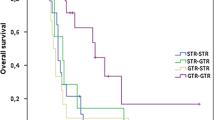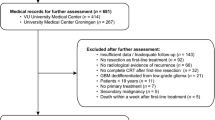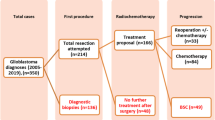Abstract
The optimal management of recurrent glioblastoma (GBM) has yet to be determined. We aim to assess the benefits of re-operation and salvage therapies (chemotherapy and/or re-irradiation) for recurrent GBM and to identify prognostic factors associated with better survival. All patients who underwent surgery for GBM between January 2005 and December 2012 followed by adjuvant radiotherapy, and who developed GBM recurrence on imaging were included in this retrospective study. Univariate and multivariate analysis was performed using Cox models in order to identify factors associated with overall survival (OS). One hundred and eighty patients treated to a dose of 60 Gy were diagnosed with recurrent GBM. At a median follow-up time of 6.2 months, the median survival (MS) from time of recurrence was 6.6 months. Sixty-nine patients underwent repeat surgery for recurrence based on imaging. To establish the benefits of repeat surgery and salvage therapies, 68 patients who underwent repeat surgery were matched to patients who did not based on extent of initial resection and presence of subventricular zone involvement at recurrence. MS for patients who underwent re-operation was 9.6 months, compared to 5.3 months for patients who did not have repeat surgery (p < 0.0001). Multivariate analysis in the matched pairs confirmed that repeat surgery with the addition of other salvage treatment can significantly affect patient outcome (HR 0.53). Re-operation with additional salvage therapies for recurrent GBM provides survival prolongation at the time of progression.


Similar content being viewed by others
References
Minniti G et al (2010) Patterns of failure and comparison of different target volume delineations in patients with glioblastoma treated with conformal radiotherapy plus concomitant and adjuvant temozolomide. Radiother Oncol 97(3):377–381
Batchelor TT et al (2013) Phase III randomized trial comparing the efficacy of cediranib as monotherapy, and in combination with lomustine, versus lomustine alone in patients with recurrent glioblastoma. J Clin Oncol 31(26):3212–3218
Wick W et al (2010) Phase III study of enzastaurin compared with lomustine in the treatment of recurrent intracranial glioblastoma. J Clin Oncol 28(7):1168–1174
Reardon DA et al (2012) Phase II study of carboplatin, irinotecan, and bevacizumab for bevacizumab naive, recurrent glioblastoma. J Neurooncol 107(1):155–164
Wong ET et al (1999) Outcomes and prognostic factors in recurrent glioma patients enrolled onto phase II clinical trials. J Clin Oncol 17(8):2572–2578
Brandes AA et al (2004) Second-line chemotherapy with irinotecan plus carmustine in glioblastoma recurrent or progressive after first-line temozolomide chemotherapy: a phase II study of the Gruppo Italiano Cooperativo di Neuro-Oncologia (GICNO). J Clin Oncol 22(23):4779–4786
Kappelle AC et al (2001) PCV chemotherapy for recurrent glioblastoma multiforme. Neurology 56(1):118–120
Friedman HS et al (2009) Bevacizumab alone and in combination with irinotecan in recurrent glioblastoma. J Clin Oncol 27(28):4733–4740
Kreisl TN et al (2009) Phase II trial of single-agent bevacizumab followed by bevacizumab plus irinotecan at tumor progression in recurrent glioblastoma. J Clin Oncol 27(5):740–745
Vredenburgh JJ et al (2007) Bevacizumab plus irinotecan in recurrent glioblastoma multiforme. J Clin Oncol 25(30):4722–4729
Easaw JC et al (2011) Canadian recommendations for the treatment of recurrent or progressive glioblastoma multiforme. Curr Oncol 18(3):e126–e136
Network, NCCN Clinical Practise Guidelines in Oncology: central nervous system. (2014) http://www.nccn.org.
Niyazi M et al (2012) Irradiation and bevacizumab in high-grade glioma retreatment settings. Int J Radiat Oncol Biol Phys 82(1):67–76
Ciammella P et al (2013) Hypofractionated stereotactic radiation therapy for recurrent glioblastoma: single institutional experience. Radiat Oncol 8(1):222
Park KJ et al (2012) Salvage gamma knife stereotactic radiosurgery followed by bevacizumab for recurrent glioblastoma multiforme: a case-control study. J Neurooncol 107(2):323–333
Cuneo KC et al (2012) Safety and efficacy of stereotactic radiosurgery and adjuvant bevacizumab in patients with recurrent malignant gliomas. Int J Radiat Oncol Biol Phys 82(5):2018–2024
Gutin PH et al (2009) Safety and efficacy of bevacizumab with hypofractionated stereotactic irradiation for recurrent malignant gliomas. Int J Radiat Oncol Biol Phys 75(1):156–163
Combs SE et al (2005) Stereotactically guided fractionated re-irradiation in recurrent glioblastoma multiforme. J Neurooncol 74(2):167–171
Nieder C et al (2008) Improvement, clinical course, and quality of life after palliative radiotherapy for recurrent glioblastoma. Am J Clin Oncol 31(3):300–305
McKenzie JT et al (2013) Hypofractionated stereotactic radiotherapy for unifocal and multifocal recurrence of malignant gliomas. J Neurooncol 113(3):403–409
Ruben JD et al (2006) Cerebral radiation necrosis: incidence, outcomes, and risk factors with emphasis on radiation parameters and chemotherapy. Int J Radiat Oncol Biol Phys 65(2):499–508
Hall WA et al (1995) Stereotactic radiosurgery for recurrent malignant gliomas. J Clin Oncol 13(7):1642–1648
Cho KH et al (1999) Single dose versus fractionated stereotactic radiotherapy for recurrent high-grade gliomas. Int J Radiat Oncol Biol Phys 45(5):1133–1141
Combs SE et al (2005) Efficacy of fractionated stereotactic reirradiation in recurrent gliomas: long-term results in 172 patients treated in a single institution. J Clin Oncol 23(34):8863–8869
Ammirati M et al (1987) Reoperation in the treatment of recurrent intracranial malignant gliomas. Neurosurgery 21(5):607–614
Harsh, G.R.t. et al (1987) Reoperation for recurrent glioblastoma and anaplastic astrocytoma. Neurosurgery 21(5):615–621
De Bonis P et al (2013) The influence of surgery on recurrence pattern of glioblastoma. Clin Neurol Neurosurg 115(1):37–43
Park JK et al (2010) Scale to predict survival after surgery for recurrent glioblastoma multiforme. J Clin Oncol 28(24):3838–3843
Park CK et al (2013) A practical scoring system to determine whether to proceed with surgical resection in recurrent glioblastoma. Neuro Oncol 15(8):1096–1101
Ryken TC et al (2014) The role of cytoreductive surgery in the management of progressive glioblastoma: a systematic review and evidence-based clinical practice guideline. J Neurooncol 118(3):479–488
Barbagallo GM, Jenkinson MD, Brodbelt AR (2008) ‘Recurrent’ glioblastoma multiforme, when should we reoperate? Br J Neurosurg 22(3):452–455
De Bonis P et al (2013) The impact of repeated surgery and adjuvant therapy on survival for patients with recurrent glioblastoma. Clin Neurol Neurosurg 115(7):883–886
Mandl ES et al (2008) Repeated surgery for glioblastoma multiforme: only in combination with other salvage therapy. Surg Neurol 69(5):506–509 (discussion 509).
Barker FG 2nd et al (1998) Survival and functional status after resection of recurrent glioblastoma multiforme. Neurosurgery 42(4):709–720 (discussion 720-723).
Keles GE et al (2004) Volume of residual disease as a predictor of outcome in adult patients with recurrent supratentorial glioblastomas multiforme who are undergoing chemotherapy. J Neurosurg 100(1):41–46
Butowski NA, Sneed PK, Chang SM (2006) Diagnosis and treatment of recurrent high-grade astrocytoma. J Clin Oncol 24(8):1273–1280
Bloch O et al (2012) Impact of extent of resection for recurrent glioblastoma on overall survival: clinical article. J Neurosurg 117(6):1032–1038
Quick J et al (2014) Benefit of tumor resection for recurrent glioblastoma. J Neurooncol 117(2):365–372
Chaichana KL et al (2013) Multiple resections for patients with glioblastoma: prolonging survival. J Neurosurg 118(4):812–820
Author information
Authors and Affiliations
Corresponding author
Rights and permissions
About this article
Cite this article
Azoulay, M., Santos, F., Shenouda, G. et al. Benefit of re-operation and salvage therapies for recurrent glioblastoma multiforme: results from a single institution. J Neurooncol 132, 419–426 (2017). https://doi.org/10.1007/s11060-017-2383-2
Received:
Accepted:
Published:
Issue Date:
DOI: https://doi.org/10.1007/s11060-017-2383-2




